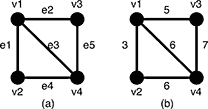POJ3522 Slim Span(kruskal)
来源:互联网 发布:汤珈铖 知乎 编辑:程序博客网 时间:2024/06/05 11:55
Description
Given an undirected weighted graph G, you should find one of spanning trees specified as follows.
The graph G is an ordered pair (V, E), where V is a set of vertices {v1, v2, …, vn} and E is a set of undirected edges {e1, e2, …, em}. Each edge e ∈ E has its weight w(e).
A spanning tree T is a tree (a connected subgraph without cycles) which connects all the n vertices with n − 1 edges. The slimness of a spanning tree T is defined as the difference between the largest weight and the smallest weight among the n − 1 edges of T.

Figure 5: A graph G and the weights of the edges
For example, a graph G in Figure 5(a) has four vertices {v1, v2, v3, v4} and five undirected edges {e1, e2, e3, e4, e5}. The weights of the edges are w(e1) = 3, w(e2) = 5, w(e3) = 6, w(e4) = 6, w(e5) = 7 as shown in Figure 5(b).

Figure 6: Examples of the spanning trees of G
There are several spanning trees for G. Four of them are depicted in Figure 6(a)~(d). The spanning tree Ta in Figure 6(a) has three edges whose weights are 3, 6 and 7. The largest weight is 7 and the smallest weight is 3 so that the slimness of the tree Ta is 4. The slimnesses of spanning trees Tb, Tc and Td shown in Figure 6(b), (c) and (d) are 3, 2 and 1, respectively. You can easily see the slimness of any other spanning tree is greater than or equal to 1, thus the spanning tree Td in Figure 6(d) is one of the slimmest spanning trees whose slimness is 1.
Your job is to write a program that computes the smallest slimness.
Input
The input consists of multiple datasets, followed by a line containing two zeros separated by a space. Each dataset has the following format.
Every input item in a dataset is a non-negative integer. Items in a line are separated by a space. n is the number of the vertices and m the number of the edges. You can assume 2 ≤ n ≤ 100 and 0 ≤ m ≤ n(n − 1)/2. ak and bk (k = 1, …, m) are positive integers less than or equal to n, which represent the two vertices vak and vbk connected by the kth edge ek. wk is a positive integer less than or equal to 10000, which indicates the weight of ek. You can assume that the graph G = (V, E) is simple, that is, there are no self-loops (that connect the same vertex) nor parallel edges (that are two or more edges whose both ends are the same two vertices).
Output
For each dataset, if the graph has spanning trees, the smallest slimness among them should be printed. Otherwise, −1 should be printed. An output should not contain extra characters.
Sample Input
4 51 2 31 3 51 4 62 4 63 4 74 61 2 101 3 1001 4 902 3 202 4 803 4 402 11 2 13 03 11 2 13 31 2 22 3 51 3 65 101 2 1101 3 1201 4 1301 5 1202 3 1102 4 1202 5 1303 4 1203 5 1104 5 1205 101 2 93841 3 8871 4 27781 5 69162 3 77942 4 83362 5 53873 4 4933 5 66504 5 14225 81 2 12 3 1003 4 1004 5 1001 5 502 5 503 5 504 1 1500 0
Sample Output
1200-1-110168650
要求一个满足条件(最细)的生成树,如果没有生成树输出-1
对次我们就要枚举生成树,但暴力枚举肯定不行,既然与边的最大值最小值有关,就想到kruskal
对于一个图来说,最小生成树不是唯一的,但最小生成树的
最小生成树的性质, 一个图的最小生成树不一定是唯一的,但是组成这些最小生成树的各个边的权值一定都是一一对应相同的
所以对于每一个最小值,形成的最小生成树都有唯一的最大值,因此每次删去最小边,求最小生成树,就能考虑所有的情况
#include <iostream>#include<stdio.h>#include<string.h>#include<queue>#include<algorithm>using namespace std;const int N=105;int f[N],n,m,flag,ans;struct node{ int u,v,w;}e[N*N];int getf(int x){ if(f[x]==x)return x; f[x]=getf(f[x]); return f[x];}bool mix(int x,int y){ int tx=getf(x); int ty=getf(y); if(tx!=ty) { f[tx]=ty; return true; } return false;}bool cmp(node a,node b){ return a.w<b.w;}void init(){ for(int i=1;i<=n;i++) f[i]=i;}void kruskal(int x){ init(); int cnt=0,minn=0x3f3f3f3f,maxx=0; for(int i=x;i<=m;i++) { if(mix(e[i].u,e[i].v)) { minn=min(e[i].w,minn); maxx=max(e[i].w,maxx); cnt++; } if(cnt==n-1){flag=1;ans=min(ans,maxx-minn);break;} }}int main(){ while(~scanf("%d%d",&n,&m)&&n+m) { flag=0,ans=0x3f3f3f3f; for(int i=1;i<=m;i++) scanf("%d%d%d",&e[i].u,&e[i].v,&e[i].w); sort(e+1,e+1+m,cmp); for(int i=1;i<=m;i++) { kruskal(i); } if(!flag)printf("-1\n"); else printf("%d\n",ans); } return 0;}- POJ3522 Slim Span(kruskal)
- UVa1395&POJ3522--Slim Span【kruskal】瓶颈生成树
- POJ3522 Slim Span
- POJ3522:Slim Span
- poj3522 - Slim Span
- poj3522 Slim Span
- POJ3522-Slim Span
- poj3522 Slim Span
- Slim Span poj3522
- poj3522 Slim Span
- POJ3522 - Slim Span (Japan 2007)
- poj3522 Slim Span 最长边与最短边差值最小的生成树,kruskal算法 + 暴力枚举
- POJ3522 Slim Span 解题报告【Kruskal求最小生成树+枚举】
- POJ3522 Slim Span(最小生成树,Kruakal)
- 【hdu】 Slim Span (kruskal)
- POJ 3522 slim span Kruskal
- POJ3522——Slim Span(最小生成树)
- POJ 3522 Slim Span kruskal+枚举。
- docker的五种网络模式总结
- Eclipse Debug 界面应用详解——Eclipse Debug不为人知的秘密
- MoviePy 数据动态可视化 图像转动态图或者视频
- NCO3.0连接SAP报错处理Could not load file or assembly 'sapnco' or one of its dependencies
- 在 MVVM 中使用 RACSubject 可以非常方便地实现统一的错误处理逻辑
- POJ3522 Slim Span(kruskal)
- 7-spring源码3.2.18解读+spring技术内幕(关于BeanDefinition的注册)
- Java项目跨域问题解决方案总结
- codeforces821 C(栈操作)
- malloc/free用法
- 内存释放和作用域销毁
- eclipse打不开android源码
- 高通8909平台AEC测试方法总结
- 类加载器


